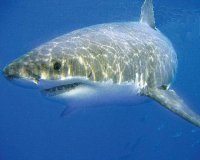
The Great white Shark, other wise known as the (White pointer) is the most popular and deadliest of sharks in the ocean. They are an aggressive, meat eating shark. The great white is also the largest, and the tiger shark is the second largest.
You do not hear much about the Great white around our shores, but they are found around New Zealand. Coastal as well as oceanic entering shallow bays and harbours. Occurs around New Zealand, but not abundant.
They dont like the water too hot nor cold but tend to like it warm, so they can be found around most of the temperate coastlines around the world.
They have been seen around such coasts of the United States and most of the Gulf Coast, Hawaii, South America, South Africa, Austrailia, West Africa and parts of East China.
They are solitary animals but on occasion have been seen travelling in pairs.
Like other sharks they have no gas filled bladder to keep them afloat like bony fish do. Hense Great Whites must keep moving in order to breath and as not to sink to the bottom of the sea.
They use there big powerful tails to propel them in the water. The fins are only used for balance.
They generally cruise at about 2 mph but can give a large burst of speed up to about 10kph or 15mph when trying to catch prey.
Great Whites are also only one of a couple of species of shark that is able to jump out of the water while catching prey.
This Shark is not really white at all. It is actually a grey or blue/gray in color on the top and only white on it's underside, This colouration makes it hard to spot in the water.
Normally a fully grown mature Great White will be in the 4-5mts or 13' to 17' range and weigh around 100 to 200kg or 2000 to 4000lbs. Though Great Whites can exceed 7mts or 20' in length and weigh in at over 3175kgs or 7000lbs. Females are also larger than the males.
Their teeth are large, triangular, and serrated. The teeth in a mature Great Whites are usually 30mm to 50mm or 1.5" to 2" long, but there are known modern teeth that are over 62mm or 2.5" long.
The biggest Great White fossil tooth found was over 85mm or 3.5" long.
The Great White sharks eyesight and hearing are less important when hunting for food, so they tend to primarily use their sense of smell and electic charges. (their nostrils can smell one drop of blood in 100lts or 25gals of water.
Great Whites do not chew their food, they take massive bites and swallow the peices whole.
The main diet for these animals are sea lions and seals, but they will also eat Turtles, Otters, smaller whales and if they can find any they will also eat dead fish.
Most attacks on humans from these animals are mainly because they think you are one of its primary meals, (seals) but after one bite it will usually back off as it notices its not.
The initial attack is used to disable the creature for easy eating. This is why if you get attacked by a great white the chances are 50/50 for survival. Mainly due to blood loss is the reason most people would die.
Female great white sharks usually bear their first young when they are 12 to 14 years old.
The young white sharks hatch from eggs, but the eggs are still inside the mothers body. There is no Placenta to nourish the young pups so they must eat the unfertilized eggs or eat their siblings to stay alive.
So even before they are born they must kill and fend for themselves.
Once the mother gives birth the young sharks swim immediately away and no maternal care is givin, as their mother may see them only as prey... Many baby sharks do not survive their first year.
Females give birth to 7 to 9 pups per litter. At birth the baby shark is already about 1.5mts or 5' long.
The young Great White sharks do not mature until they reach the age of about 10 to 12 years old.
I do not know the life span of the Great White Shark although I have read that some believe it to be around 100 years.
At the time of writing this the Great White shark is NOT an endangered species, but, they are decreasing in big numbers and may eventually become on this list.